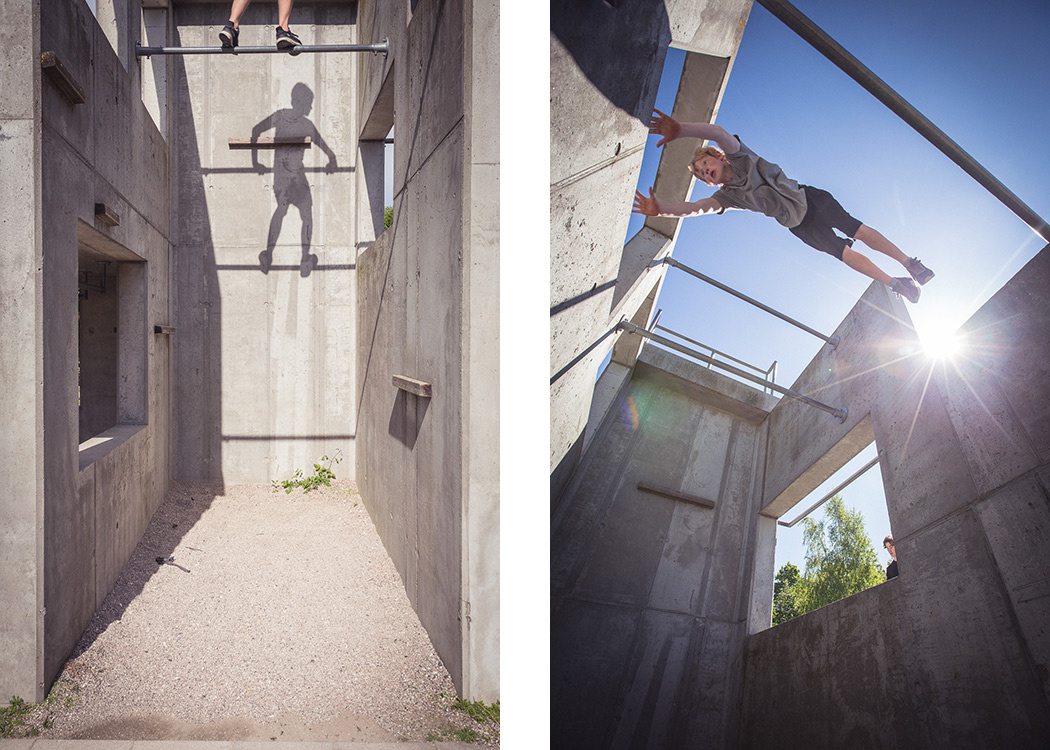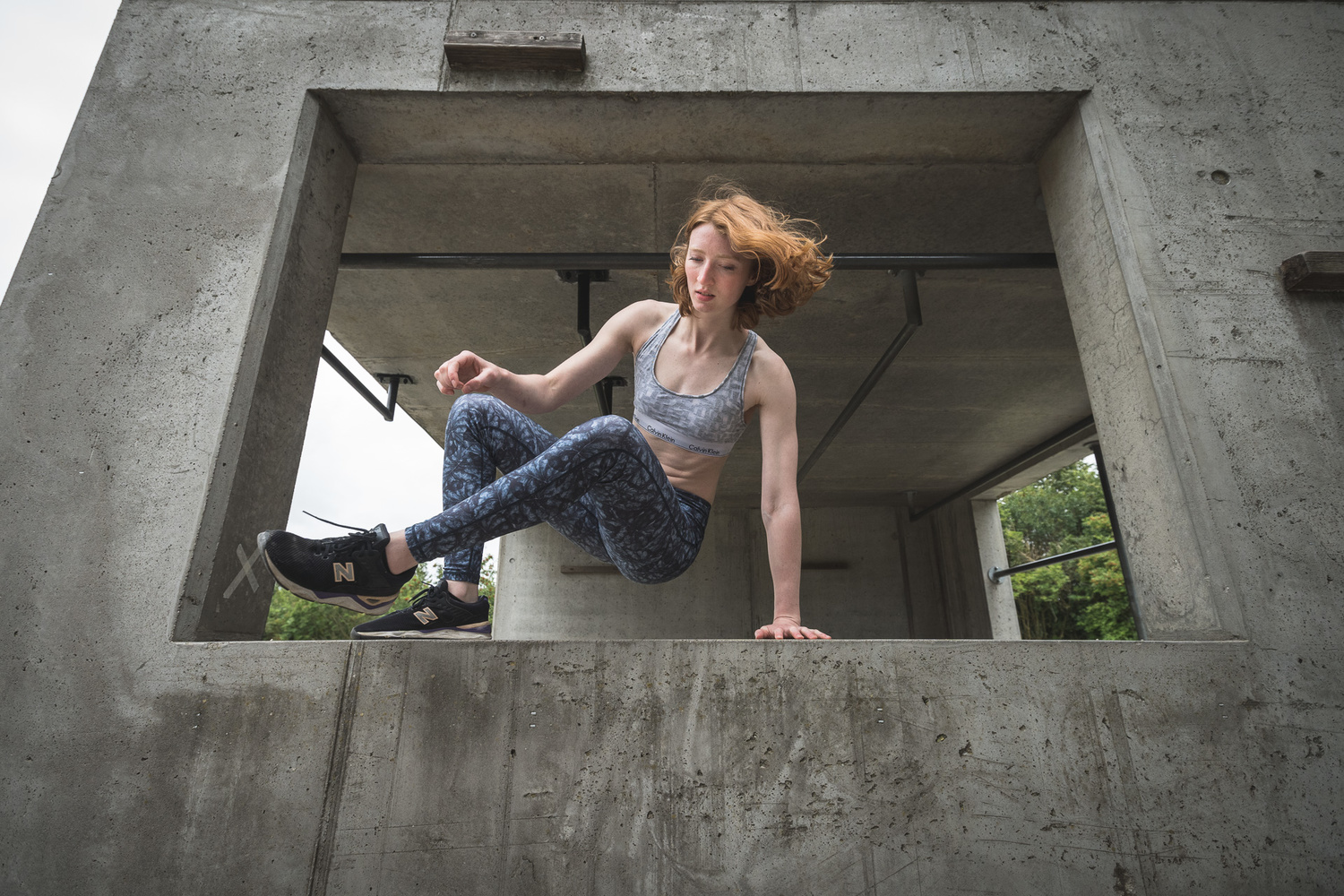Sometimes it’s fun to set yourself a challenge, maybe shooting with limited gear or with a very quick turnaround. On this occasion, I had no choice. The shoot was conceived and captured in under fifteen minutes, and the images were edited and submitted less than half an hour later. Here’s how it came about.
Every July I attend the International Gathering at Gerlev Idrætshøjskole in Denmark. This brings together more than 150 people from around the world to dance, train parkour, and study movement. I’m there to document the week-long event, take part in some of the training, give a talk about strange monuments, and teach some buildering workshops.
Also attending was Hazel Townsend, a model with Storm Management who also performs as an actress and a clown — as well as training parkour. After lunch one day, she mentioned that her agency was about to put her forward for a job shooting for a sports clothing label but her entire portfolio was of high-end fashion. You can see what she’s typically photographed wearing by checking out her Instagram.
“How soon do you need the shots?” I asked. “Well, my agent needs to send them off this afternoon,” she replied. Plenty of time, I thought, and offered my services. Portraiture is one of the weakest parts of my photography and deliberately taking myself out of my comfort zone was in keeping with the week’s training.
While it offers some incredible facilities, the school (if you can call it that — it’s for adults and teaches subjects like windsurfing, judo, basketball, and parkour) is far from photogenic. Furthermore, being in the middle of the day, the light was not ideal. In Denmark the sun never gets too high but for this simple shoot we definitely needed something as diffused as possible to avoid heavy shadows across Townsend’s face. There was a fair amount of cloud cover but the sun was still regularly breaking through.
Among the school’s proudest features is its purpose-built parkour training facility, one of the earliest ever built around the world. Looking a bit like a 1960s multi-storey carpark designed by M.C. Escher but on a much smaller scale, its plain walls act a little like reflectors, evening out harsh light, and feeling relatively bright even deep in its darkest corners.
In the center of the structure is a tower, enclosed on three sides. At that time of day, some light was coming into the top but at enough of an angle that the base of the tower’s interior was entirely in the shade. The light gray of the walls meant that, despite this shadow, it was still fairly bright, giving completely soft light. Combined with the relatively clean background, it was the most obvious place to shoot portraits.

The tower at the center of the parkour structure at Gerlev. Gray walls reflecting lots of soft light made it the most obvious choice to shoot a batch of portraits. Click for bigger.
My gear for a week at Gerlev is quite limited (traveling light is both a necessity and a preference). Most of the time I have my Canon EF 16-35mm f/2.8 L Mark II (link is to the Mark III) to capture action, this year attaching it to my new Sony a7 III which recently replaced my Canon 6D (link is to Mark II). Also in my bag is Sony’s nifty fifty which was heavily discounted when I bought it in December last year. This is a cheap lens: I love the size and the weight and an aperture of f/1.8 is enough to soften a background for my purposes. Most of the time, I don’t need insane levels of sharpness and while the blue fringing as a result of chromatic aberration can be quite heavy occasionally, I don’t mind it too much. I hope to upgrade to the ZEISS 55mm at some point in the next year or two.
I’m not sure why it needed me to switch to Sony to start photographing in aperture priority with auto ISO, but that’s now by far my favorite method when shooting portraits. I have a custom mode on the dial of my a7 III ready for such occasions, which also automatically switches on both the front and rear mechanical shutter (here's why). All of this means that suddenly shifting to portraits (whether that’s from capturing action or when I randomly pick up my camera while hanging out with friends) is easy and effortless, not having to give much thought to my exposure beyond occasionally peaking at my histogram.
I started pushing myself to shoot more portraits about eighteen months ago and moving to Sony and having eye autofocus has been something of a game-changer. Even with Sony’s cheapest lens, it’s fast and consistent, though understandably it can struggle in low light. To capture Townsend as she posed for me, I didn’t have to think about focusing once.
Most of my practice with portraits has been with friends and family. I’ve never really had an idea of how to ask people to behave or pose in front of the camera, and none of my subjects until this shoot had any modeling experience. With Townsend, suddenly she was shifting between poses, holding each for a couple of seconds before moving to something else. She moved her weight from side to side, forward and back, head straight then tilted, hair forward, hair back — stuff I’ve seen on YouTube but never experienced in the flesh. It’s an art in itself.

Halfway through the series of portraits, I realized I was cropping below the knee and wondered whether that was going to be a good idea. Full length was going to bring in too much of the background and become messy, but going tighter would mean getting a bit too close given the nature of the 50mm. I opted to continue cutting Townsend off at the knee with the plan to crop in afterwards. It also meant that it was easier to keep the vertical lines in the background vertical. In addition, I seem to have a complete inability to hold a camera straight when I’m rushing so it made sense to give myself a bit of breathing space in the edit.
In the space of less than 90 seconds, I shot 26 images. We had a quick glance through the shots on the back of the camera together, checked sharpness on one or two of Townsend’s favorites, and decided to move on to some action. This time, in three minutes, I shot Townsend vaulting over a wall seven times and produced 49 shots using the a7 III’s 10 frames-per-second. In the past, with my Canon 6D, I would have relied on my timing; one of my reasons for upgrading was to invest in some speed, a luxury I’ve not enjoyed since the shutter on my Canon 1D Mark III failed halfway through a trip around Italy back in 2008.
For the action shots, I switched to my 16-35 and swapped over to my other custom mode: high speed continuous, manual exposure, shutter speed dialed to 1/1000th, aperture at f/5.6, and the ISO set to auto. I very rarely track subjects and I’m very accustomed to pre-focusing, using the wall where Townsend was vaulting as my guide. With the wide-angle lens and a relatively small aperture, it’s very rare that I miss focus when choreographing action.
The spot I chose didn't have much space I and ended up fairly close to Townsend, thus having to shoot at 16mm. When you’re this wide, it’s important to keep an eye on any parts of the body that stray towards the edges of the frame. Hands can quickly become alien and feet can easily turn into clown shoes.

A simple vault. Notice how much bigger the feet become as they move closer both to the camera and to the edge of the frame.
The movement that I asked Townsend to perform was very easy for her. In the world of parkour, it’s called the “safety vault” for good reason: it’s incredibly simple. Given the time constraints and the lack of any reason to do something more complicated, it made the most sense. After two vaults (15 photographs), I knew I had something that worked.
Having grabbed it so quickly, I figured I would cover myself with another quick setup. We stepped across to another nearby wall and did a slightly different vault. Looking back, all of this was completely unnecessary: the movement wasn’t as fluid, the framing wasn’t as strong, and the shots were nowhere near as good. It was time to edit.
I tend to be very light on my editing so I was confident of a quick turnaround in Lightroom. As Townsend hadn’t looked through the shots fully, I wanted to give her a good choice of portraits. I chose 16 from the 26, threw on one of my presets and added a radial filter to the face to drop the clarity and lift the shadows slightly. My preset was a touch gritty and isn’t the most flattering to female faces; adding the radial filter allowed me to offset this a little.

One of Townsend's favourites — straight out of camera (left) and after my light edit. This was after I realized I was cutting off Townsend below the knee a bit too much so it didn't require much cropping in Lightroom. 50mm, 1/4000 sec, f/1.8, ISO 100. Click for bigger.
The one other very quick edit was to paint in a local adjustment layer to drop the exposure on Townsend’s chest and shoulders. I hadn’t spotted it when shooting but the way the light was falling meant that this part of her body was slightly brighter than her face.
The action shots were easier: the same preset and a tiny bit of cropping in order to straighten up anything that looked wonky. Export at 1920px straight to dropbox and email Townsend a link. Super fast.

Hazel Townsend: model, actress, clown, parkour athlete. 16mm, 1/1000 sec, f/5.6, ISO 800. Click for bigger.
Looking back, there’s probably a load of things that I could have done differently but I’m pleased with the results, especially under the conditions. Let me know your thoughts in the comments.







I like your photos a heck of a lot better then the fashion pic you included. Nice job making do with drab cement and poor light!
Thanks! :)
Nice work, thanks for the article.
Thanks! Glad it was of interest. :)
One comment you made that has always struck me- how incredible it is to work with professional models. Striking pose after pose (and if you shoot with a strobe they know exactly when to change- each 'pop'!) The efficiency and ease of shooting is fantastic...
From my very limited experience - yes! Hazel was so easy to work with, not just for the posing but for the whole shoot. I should have discussed this more in the article, i realise now!
This! I think modelling skills are underrated, but the difference between shooting with someone who practices what they do continuously, and someone who just 'looks good' is night and day. Even amateur models who take their job seriously are a joy to shoot.
15 minutes is not enough time. I would start with 30 minutes at a minimum!
Good photos! I do a series where the entire shoot is done in just 60 seconds. If the model comes in already knowing how to pose, and with a few test photos taken to determine exposure, the timer is set on 1 minute. You can easily get 30-40 photos with that schedule, and really get a challenge.
Thanks! And that sounds like a fun challenge.